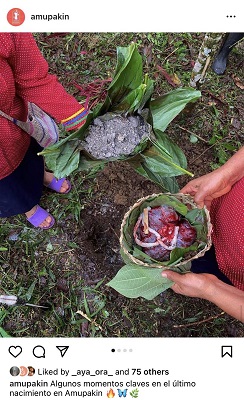Midwifery and the Ecological Environment
Interviews with Indigenous Kichwa Midwives in Ecuador
31.07.2024
By Markos Panayiotou
Supervisor: Dr. Susanne B. Unger
The aim of my final project was to examine the relationship between midwifery and the ecological environment from a cross-cultural, comparative perspective. To achieve this goal, I conducted semi-structured interviews with indigenous Kichwa midwives in Ecuador, as well as with midwives studying and working in various regions in Germany. In the course of these discussions, I strived to gain insights into diverse perspectives on the topic of birth, as well as into different perceptions of the (ecological) environment. The comparative approach of the project allowed me to question my own presuppositions and even to look at familiar concepts, such as medicine and health, with new eyes. Finally, I created an Instagram page (@Birthing_Environments) where I shared parts of my project.
To start with, members of the Kichwa midwife association Amupakin perceived birth as a multispecies process. Aided by gravity, the “ancestral” or “natural” way of giving birth involves being in a vertical position, while holding a liana or a thick rope. During pregnancy, local midwives enter into a reciprocal relationship with spirit masters, perceived as inhabiting the surrounding ecology of forests and rivers. After birth, the placenta is buried in the ground and a tree is planted over it. It is said that if the tree grows well the child will have a healthy life. In this way the indigenous midwives forged a connection between human and more-than-human health. The bodies of humans were seen as closely intertwined with the conditions of their surrounding social and ecological environments.
On the contrary, midwives studying and working in Germany tended to emphasize the constraints imposed on such more-than-human entanglements in clinical milieus. The interviewed midwives illustrated the process of the gradual professionalization and academization of their field, which came hand in hand with the "medicalization" of birth. The professionalization of midwifery practices was accompanied by increased interventions in the bodies of pregnant individuals, for instance, through the use of various medical instruments and medication, as well as the introduction of diagnostic methods and surgical procedures. These medical procedures influenced the interactions between human and non-human entities, such as the transfer of beneficial microorganisms from the mother's vaginal microbiota, which were notably constrained in the case of C-section.
The relationship between birth and the broader ecological environment was nevertheless evident in the answers of midwives in both Ecuador and Germany. The indigenous midwives in Ecuador drew parallels between environmental pollution, such as that resulting from illegal mining in the area, and the occurrence of illnesses. Similarly, in our discussions, midwives in Germany referred to ongoing research correlating heat waves and air pollution with complications in pregnancy.

Snapshots from the Instagram Page of the Midwife Association Amupakin illustrating vertical birth (top) and the process of burying the placenta (down).
Please consider supporting and making a donation in; https://amupakinachimamas.com/en/

